8+ Sample Disciplinary Action Plan
-

Disciplinary Action Plan Template
download now -
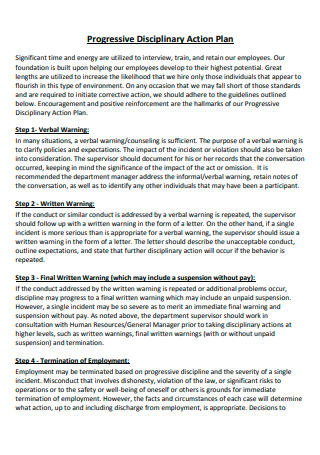
Progressive Disciplinary Action Plan
download now -
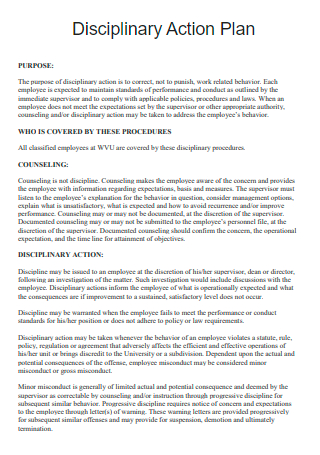
Disciplinary Action Plan Example
download now -
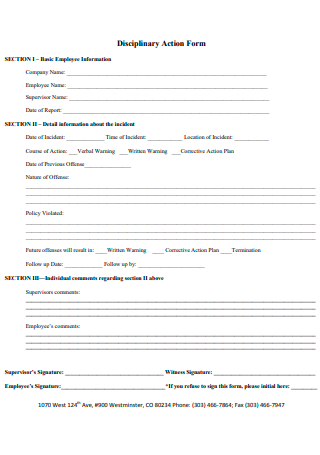
Disciplinary Action Plan Form
download now -
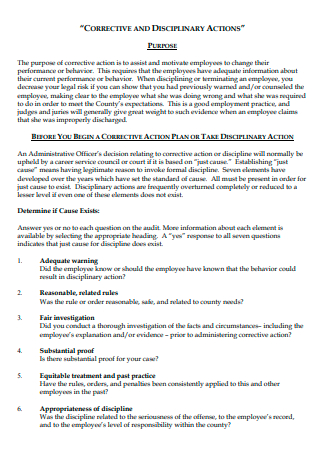
Corective and Disciplinary Action Plan
download now -

Counseling and Disciplinary Action Plan
download now -
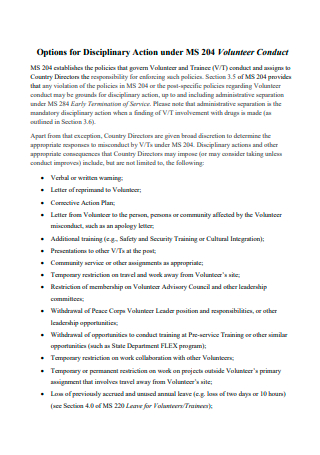
Disciplinary Action Plan in PDF
download now -
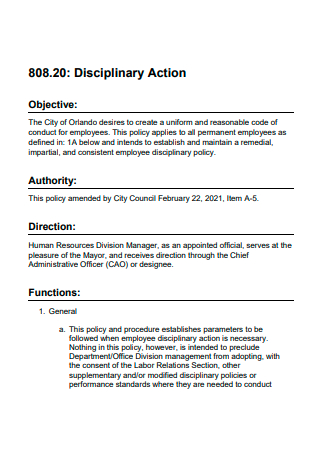
Standard Disciplinary Action Plan
download now -
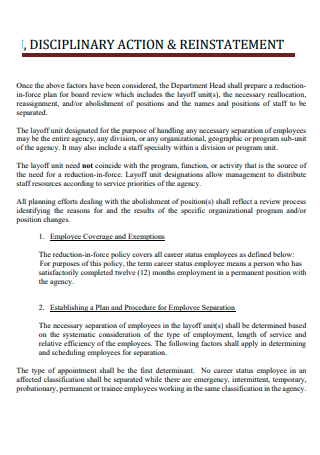
Disciplinary Action Plan and Reinstatement
download now
FREE Disciplinary Action Plan s to Download
8+ Sample Disciplinary Action Plan
What Is a Disciplinary Action Plan?
What Is the Importance of a Disciplinary Action Plan?
What Are the Factors to Be Considered Before Deciding Any Disciplinary Action?
What Are the Types of Disciplinary Action?
How Do You Write a Disciplinary Action Plan?
FAQs
What should be included in a disciplinary action plan?
What constitutes disciplinary action?
Do employees have the right to appeal the proposed disciplinary action against them?
What are the legal requirements?
What are the advantages of having a procedure for dealing with disciplinary matters?
What Is a Disciplinary Action Plan?
Most people are expected to meet performance standards and conduct themselves appropriately. This policy is meant to provide tools for addressing employee conduct and performance issues in a reasonable, consistent, and efficient manner. Any disciplinary action issued in accordance with this policy must be for just cause under one or more of the three following reasons:
- unsatisfactory job performance; or
- unacceptable personal conduct; or
- grossly inefficient job performance.
The categories are not mutually limited, as certain actions by employees may fall into more than one category, depending upon the facts of each case. However, no disciplinary action shall be invalid solely because the disciplinary action is labeled incorrectly.
The methods in this policy provide for progressive discipline to address issues involving unsatisfactory job performance for employees to be given notice of deficiencies and an opportunity to improve them. Nevertheless, this policy also recognizes that some employee conduct occurring either on-duty or off-duty is so noticeably bad and intolerable that continued employment is not a possibility and progressive discipline is not appropriate. This type of behavior is considered either unacceptable personal conduct, which can be either on-duty or off-duty, or in the case of on-duty behavior, grossly inefficient job performance. The imposition of any disciplinary action shall comply with the procedural requirements of this policy.
What Is the Importance of a Disciplinary Action Plan?
The importance of disciplinary action is to correct—not to punish—work related behavior. Every employee is expected to maintain standards of performance and conduct as outlined by the immediate supervisor and to comply with applicable policies, procedures and laws. When an employee does not meet the expectations set by the supervisor or other appropriate authority, counseling and/or disciplinary action may be taken to address the employee’s behavior.
What Are the Factors to Be Considered Before Deciding Any Disciplinary Action?
Take the major factors that need to be considered to have fair and equitable disciplinary practices before having a review of disciplinary guidelines. The following contingency factors can help analyze a discipline problem:
Additionally, there are many reasons why there is a need to discipline an employee. There could be a list of several violation that a management might believe require disciplinary action. Here are some of the most frequent violations:
Attendance. Unexcused absence, chronic absenteeism, leaving without permission.
On the Job Behavior. Work Performance problems can include action like not completing work assignments, producing substandard products, or services not meeting established production requirements.
Dishonesty and Related Problems. Theft, falsifying employment application, punching another employee’s timecard, willfully damaging organizational property, misrepresenting work records.
Other Bad Behaviors. Disobedience, sexual harassment, smoking in unauthorized places, fighting, gambling, failure to use safety devices, failure to report injuries, carelessness, sleeping at work, using abusive or threatening language with supervisors, possession of narcotics or alcohol, and possession of firearms or other weapons.
What Are the Types of Disciplinary Action?
Any career State employee, regardless of occupation, position, or profession may be warned, demoted, suspended, or dismissed by the appointing authority. The degree and type of action taken shall be based upon the sound and considered judgement of the employing agency in accordance with this policy and after consultation with the Human Resources Office.
Written Warning
The supervisor shall monitor and promote the satisfactory performance of work assignments and guarantee that employees do not engage in unacceptable personal conduct.
- Unsatisfactory Job Performance: When the supervisor determines that disciplinary action is suitable for unsatisfactory job performance, a written warning is the first type of disciplinary action that an employee shall receive. Nevertheless, the manager/supervisor shall give feedback to the employee regarding the need for him/her to improve his/her performance. If performance does not improve after the given feedback, a Documented Counseling Session (DCS) shall be issued prior to beginning disciplinary actions for most performance issues. Any disciplinary action issued for unsatisfactory job performance without a prior DCS must first be approved by the agency HR Director or designee. After the first written warning, a supervisor may give additional written warnings or a higher level of disciplinary action.
- Unacceptable Personal Conduct or Grossly Inefficient Job Performance: The supervisor may elect to issue a written warning for grossly inefficient job performance or unacceptable personal conduct. Yet, this policy does not require a written warning before management takes other disciplinary action in these types of cases.
All written warnings shall:
- Inform the employee in writing that this is a written warning, and not some other non-disciplinary process such as counseling;
- Inform the employee of the particular issues that are the basis for the warning;
- Tell the employee what specific improvements (if applicable) shall be made to address these specific issues;
- Tell the employee the timeframe allowed for making the needed improvements or corrections. Absent in a specified timeframe, 60 days is the time frame allowed for correcting unsatisfactory job performance and immediate correction is required for grossly inefficient job performance or unacceptable personal conduct; and
- Tell the employee the consequences of failing to make the required improvements or corrections.
Disciplinary Suspension Without Pay
Prior to placing an employee on disciplinary suspension without pay, a management representative shall conduct a pre-disciplinary conference with the employee in accordance with the procedural requirements of this policy. An employee may be suspended without pay for disciplinary purposes for unsatisfactory job performance after the receipt of at least one prior disciplinary action, or for causes relating to any form of unacceptable personal conduct or grossly inefficient job performance without any prior disciplinary action.
The length of a disciplinary suspension without pay for an employee who is exempted from the overtime compensation provisions of the Fair Labor Standards Act must be for at least one full work week (five work days), but not more than two full work weeks (ten work days). Therefore, the length of a disciplinary suspension for an employee on a non-forty-hour week/schedule shall be no more than 80 hours.
Demotion
As a disciplinary measure, any employee may be demoted. Demotion may be made based on unsatisfactory job performance, grossly inefficient job performance or unacceptable personal conduct. An employee may be demoted for disciplinary purposes for unsatisfactory job performance after the receipt of at least one prior disciplinary action, or for causes relating to any form of unacceptable personal conduct or grossly inefficient job performance without any prior disciplinary action.
Disciplinary demotions must be conducted in accordance with the appropriate salary administration policies. Prior to demoting an employee, a management representative shall conduct a pre-disciplinary conference with the employee in accordance with the procedural requirements of this policy.
Dismissal
Dismissal may be a result of unsatisfactory job performance, grossly inefficient job performance or unacceptable personal conduct. An employee may be dismissed for disciplinary purposes for unsatisfactory job performance after the receipt of at least two prior disciplinary actions, or for causes relating to any form of unacceptable personal conduct or grossly inefficient job performance without any prior disciplinary action.
The supervisor recommending dismissal must discuss the recommendation with appropriate agency management, including Human Resources. Upon approval by agency management, a pre-disciplinary conference shall be held with the employee.
How Do You Write a Disciplinary Action Plan?
When writing up an employee, it is important to include the following information in any disciplinary form:
Step 1: The Employee’s Name and The Date of The Write-Up
This ensures there will be no question as to who the form was referring to and when it was written.
Step 2: Clearly State Why They Are Being Written Up
Even if you have discussed it with the employee, you should document in detail the reason(s) for the write-up. This helps to protect you from any legal actions.
Step 3: How many times this employee has been written up
This can be used to show that the employee has been warned and that the next step may be termination.
Step 4: Clearly State Details About the Problem
List any evidence you have including quotes from others, dates, and details about their performance or behaviors. Be specific and be as detailed as you can be. You should be able to gather this information during your investigations.
Step 5: Give the Employee A Deadline to Fix the Problem
Writing a deadline tells them what changes are expected from them and when you expect these changes or corrective actions to be in place.
Step 6: Always Have Them Sign and Date the Write-Up
This paper trail is essential if you need to terminate them. It shows they were warned and that they understood the possible consequences for their behavior. It also shows them that this is serious. And again, it can be used in any legal actions.
Conducting a thorough investigation and following up with warning letters or write-ups helps to protect a company or an organization. It can go a long way towards helping wayward employees to get back on track.
FAQs
What should be included in a disciplinary action plan?
This disciplinary action plan covers what happens when you need to notify an employee that they should improve their performance, conduct, or attendance. It runs through the procedure for: informal warnings; investigation; criminal charges, where the employee’s conduct is part of a criminal investigation; disciplinary meetings and the employee’s right to be accompanied to them; the stages of disciplinary action; when an employee is found guilty of gross misconduct and; an employee appealing against a decision.
What constitutes disciplinary action?
Disciplinary action is important when an employee fails to satisfy established and communicated standards for performance or policies outlined in an employee handbook. Generally, the employee handbook contains information about actions that will be taken when an expectation is violated. Some usual reasons for disciplinary action are tardiness, absenteeism, disrespectfulness, work performance, dress code violation, inappropriate language, and policy or procedure violations.
Do employees have the right to appeal the proposed disciplinary action against them?
The right to appeal means that at any stage in the disciplinary process, if the employee feels it was made wrongly or unjustly, they may have the right to formally challenge a decision that has been made by a supervisor or HR. This is an important part of making a disciplinary process fair.
What are the legal requirements?
A Code of Practice has been established in relation to disciplinary and grievance procedures and is an important read for all employers and employees. Employers are not required by law to have a disciplinary procedure, but employers must, in the written statement, declare whether such a procedure is available. It is regarded as good practice to specify the person (by name or job title) to whom employees may apply if they have a grievance or wish to appeal against any disciplinary action. Details should also be given of how an employee should make such an application. Employees should be given the choice to be represented by a work colleague or union official if they are subject to formal disciplinary action.
What are the advantages of having a procedure for dealing with disciplinary matters?
It can help employers to deal fairly and consistently with disciplinary problems—including those that may involve dismissal. The tribunal will take account of whether a fair procedure was used when it decides a case.
One must act fairly and reasonably if there are grounds for disciplining an employee, for example, on grounds of misconduct or poor performance. To ensure that you do, it makes sense to establish a set of fair and reasonable rules—a disciplinary action plan that makes clear to both you and your employees how disciplinary issues will be handled, and to set those rules out in writing.
Good and humane disciplinary actions are not about penalizing employees, although sanctions may sometimes be necessary, they are also about helping and encouraging employees to prevail over any misconduct or performance issues, so they can become fully effective again and be happier in their environment.
